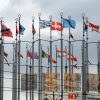Virologists are sounding the alarm about the threat of a new pandemic
Humanity is facing a new threat from a strange pandemic, scientists warn. Ancient viruses frozen in Arctic permafrost could one day be released due to Earth's warming climate and cause a major outbreak of disease, they say.

Scientists warn that Arctic zombie viruses could trigger a terrifying new pandemic, writes The Observer.
The strains of these Methuselah microbes – or zombie viruses, as they are also called, – have already been highlighted by researchers who have expressed fears that a new global health emergency could be caused — not by a disease new to science, but by a disease from the distant past.
As a result, scientists began planning an Arctic monitoring network that would allow to detect early cases of disease caused by ancient microorganisms. It would also provide quarantine and skilled medical care for infected people in an attempt to contain the outbreak and prevent infected people from leaving the region.
“At the moment, analysis of pandemic threats is focused on diseases that could arise in the southern regions and then spread north,” says geneticist Jean-Michel Claverie from Aix-Marseille University. – In contrast, little attention has been paid to an outbreak that could originate in the far north and then spread south – and I think this is an oversight. There are viruses there that could potentially infect people and cause a new outbreak of the disease.”
This view is supported by virologist Marion Koopmans from the Erasmus Medical Center in Rotterdam: “We don’t know what viruses are hiding there in the permafrost, but I think there is a real risk that there may be a virus that can cause an outbreak.” say, an ancient form of polio. We have to assume that something like this could happen.”
In 2014, Jean-Michel Claverie led a team of scientists who isolated living viruses in Siberia and showed that they could still infect single-celled organisms even though they had been buried in permafrost for thousands of years. Further research published last year revealed the existence of several different viral strains from seven different locations in Siberia and showed that they could infect cultured cells. One sample of the virus was determined to be 48,500 years old.
“The viruses we isolated were only able to infect amoebas and did not pose a threat to humans,” Claverie notes. – However, this does not mean that other viruses currently frozen in permafrost cannot cause disease in humans. We have identified genomic traces of poxviruses and herpesviruses, which are, for example, well-known human pathogens.
Permafrost covers a fifth of the northern hemisphere and consists of soil that has been stored at temperatures below freezing for a long time, writes The Observer. Scientists found that some layers remained frozen for hundreds of thousands of years.
“The key thing about permafrost is that it is cold, dark and lacks oxygen, which is ideal for preserving biological material, — Claverie told The Observer last week. – You could put yogurt in permafrost and it could still be edible 50,000 years later.
But permafrost in the world is changing, notes The Observer. The upper layers of the planet's main reserves – in Canada, Siberia and Alaska – are melting as climate change disproportionately impacts the Arctic. According to meteorologists, the region is warming several times faster than the average rate of increase in global warming.
But it is not the immediate permafrost melting that poses the immediate risk, Claverie added: “The danger comes from another impact of global warming: the disappearance of Arctic sea ice. This allows for increased shipping, traffic and industrial development in Siberia. Large-scale mining operations are planned, during which huge wells will be drilled deep in the permafrost to extract oil and ores. These operations will result in the release of huge numbers of pathogenic microorganisms that still thrive there. Miners will go inside and inhale viruses. The consequences can be catastrophic.
This point is emphasized by Marion Koopmans: “If you look at the history of epidemic outbreaks, one of the key driving forces has been changes in land use. The Nipa virus was spread by fruit bats that were driven from their habitats by humans. Likewise, monkeypox has been linked to the spread of urbanization in Africa. And this is what we will see in the Arctic: a complete change in land use, and it can be dangerous, as we have seen in other places.
Scientists believe that permafrost – at its deepest levels – may contain viruses up to a million years old, making them much older than our own species, which is thought to have emerged around 300,000 years ago.
“Our immune systems may never have been exposed to some of these microbes, and this is another concern, – notes Claverie. – The scenario in which an unknown virus that once infected a Neanderthal comes back to us, although unlikely, has become a real possibility.
For this reason, Claverie and others are working with UArctic, the University of the Arctic – international educational network in the polar region – on plans to set up quarantine facilities and provide medical expertise that could identify early cases and treat them locally to try to contain the infection: “We are facing a tangible threat now and we need to be prepared to deal with it. Everything is very simple”.






















































Свежие комментарии